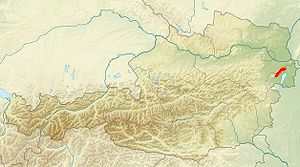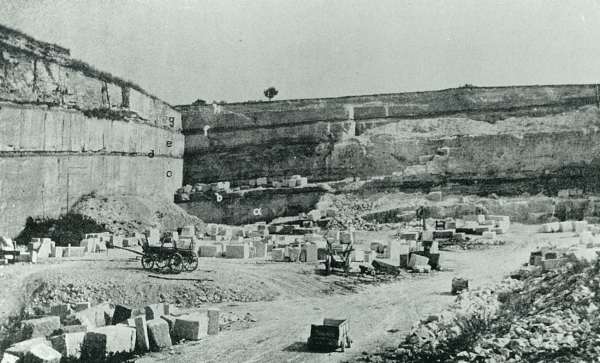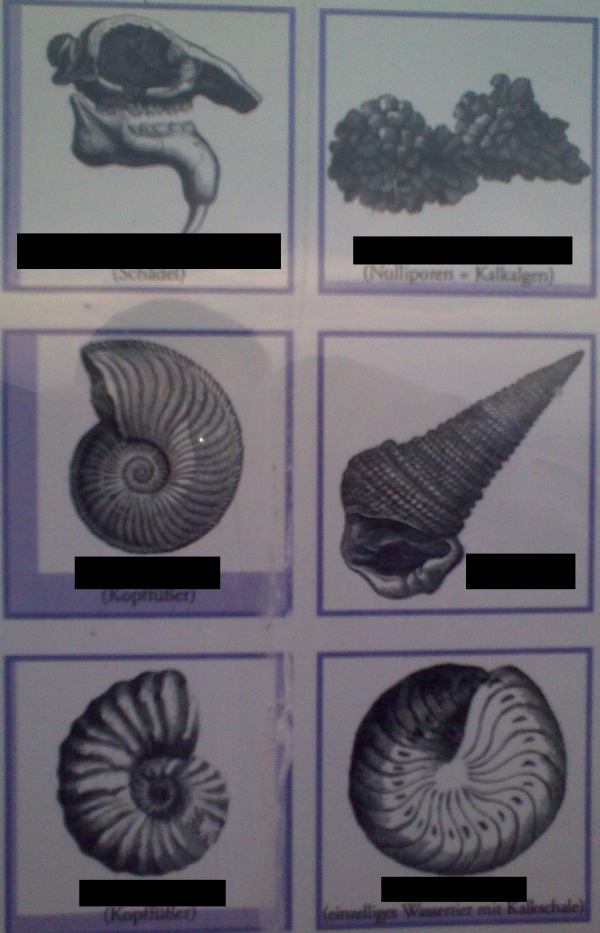|
| click here Hier klicken |
  |
|
| xxxx |
 |
| English |
| xxxx |
| It's almost a drive in where you have to walk some meters. It’s my first earthcache. That’s why I made it not to difficult. |
|
The Leitha Mountains
|
| Geographilcally the Laitha Mountains are the county boarder between „Niederösterreich“ and „Burgenland“. The Leitha Mountains have 35 km in length and 5-7 km in width. They are the extension of the Alps and a connection to the Carpathian Mountains in the North. The highest hill has 484 m and is called „Sonnenberg. |
| xxxx |
 |
| xxxx |
| The Leitha Mountains are strongly formed by effects of mankind. The range of the economic use was from agriculture till mining of the Leitha lime in enormous stone quarries. The huge exposures from former usage of the lime stone are still witnesses of a strong stonemason history in the area. |
| xxxx |
The Leitha lime stone
|
| The Leitha lime is a lime stone named by the Leitha Mountains in the East of Austria. It’s a bright and cellular lime stome from the tertiary time (about 65 million years till about 2,6 million years ago), which was built mainly from fragments of the skeletons of the sessile red algae’s. The bright ochre colored lime form Loretto can be identified by dark springels. In the lime stone from Eggenburg, a lime sand stone, you can find a lot of bryozoan and further fossils, quartz, muscovite and feldspar. |
| xxxx |
 |
| xxxx |
Usage of Leith lime
|
| Dependent form the consistence and structure of the Leitha lime the usage differed from „Reibsand“ till building material. The Leitha lime stone is an natural stone which can be formed easily and was desired als beautiful stone for buildings in Roman times. The usage of lime stone from Eggenburg in the Bronze age already was verified. This special attribute is the reason why the Leitha lime was taken from sculptors and masons. |
| The source of lime stone in the Leitha Mountains was important for Austria and especially for Vienna from cultur historical point of view during the Renaissance and Baroque. At the 19th century the up to 150 stone quarries of the Leitha mountains got many orders form the construction work of the Vienna „Ring road“. |
| At many buildings of Graz, such as the castle at the Grazer castle hill, the old Joanneum and the Cottage, the Leitha lime stone was used. |
| Due to the fact that Leitha lime is bond on carbonate in the texture, the alteration through the actual sour rain is heavy. |
| xxxx |
Leitha lime stone in Burgenland
|
| In the county of Burgenland Leitha lime stone can be found in the „Kaisersteinbruch“ in a hard till very hard texture. The Breitenbrunner sculptor lime stone can be shaped easily. Loretto is still mined at St. Margarethen as St. Margareten lime stone und used as cut stone. In Müllendorf/Burgenland companies produce chalk with the local Leitha lime. |
| xxxx |
 |
| xxxx |
The task
|
| 1. Finde the 5 (!) Latin names of the shown fossils (info board can be found at waypoint 1. Please do not write the solutions into your log! Please send them to me by email. |
| xxxx |
 |
| xxxx |
| 2. Please make a picture of your GPS/yourself at the photo point 1 (info board) and photo point 2 (open lime). Please take care not to show the solutions of task 1 on your pictures! You can log the cache with the pictures without my preliminary approval. I will check the solutions later. |
| xxxx |
| xxxx |
|
| xxxx |
If you like to rate the cache I'm happy if you use GCvote. Please tell your true opinion about the cache in the log. If you do not like something, please write it down. I'll see what will be possible to do it better. Maybe you have an idea how to improve too.  |
back to the top  |
to the end click here |
|
| xxxx |
 |
| Deutsch |
| xxxx |
| Es ist fast ein Drive In bei dem man ein paar Meter laufen muss. Es ist mein erster Earthcache, daher habe ich ihn eher leicht gestaltet. |
|
Das Leithagebirge
|
| Das Leithagebirge liegt geografisch an der Landesgrenze zwischen Niederösterreich und dem Burgenland. Die Leithaberge, wie sie umgangssprachlich auch heißen, ist ein ca. 35 km langer und 5-7 km breit. Als Ausläufer der Alpen bildet das Leithagebirge eine Verbindung zu den Karpaten im Norden. Die höchste Erhebung ist mit 484 m ü. A. der Sonnenberg. |
| xxxx |
 |
| xxxx |
| Das Leithagebirge ist in weiten Teilen stark durch menschliche Einflüsse geprägt. Die wirtschaftliche Nutzung reichte von der Landwirtschaft bis hin zum Abbau des Leithakalkes in gewaltigen Steinbrüchen. Die mächtigen Aufschlüsse teilweise vergangener Nutzung sind noch heute Zeugen einer starken Steinmetzvergangenheit des Raumes. |
| xxxx |
Der Leithakalk
|
| Der Leithakalk ist ein Kalkstein, der nach dem Leithagebirge in Ostösterreich benannt ist. Er ist ein heller, fester, zelliger und tertiärer Kalkstein (vor 65 Millionen Jahren bis vor rund 2,6 Millionen Jahren), der zum größten Teil aus Skelettfragmenten von kalkabscheidenen Rotalgen besteht. Der helle ockerfarbene Lorettokalk kann an den punktförmigen dunklen Einsprenglingen unterschieden werden und im Eggenburger Stein, ein Kalksandstein, befinden sich massenhaft Moostierchen und weitere Versteinerungen sowie Quarz, Muskovit (Mineral der Silikate) und Feldspat. |
| xxxx |
 |
| xxxx |
Verwendung
|
| Je nach Beschaffenheit und Struktur des Leithakalkes war der Verwendungszweck für Reibsand oder auch Baumaterial gegeben. Der Leithakalk ist ein leicht zu bearbeitender Naturstein, der bereits zur Römerzeit ein begehrter Baustein war. Der Eggenburger Stein wurde nachweislich bereits in der Bronzezeit abgebaut. Leithakalk lässt sich leicht bildhauerisch formen und wird deswegen von Steinmetzen und Steinbildhauern häufig verwendet. |
| Es handelt sich um Gesteinsvorkommen, die für Österreich, vor allem Wien, von großer kulturhistorischer Bedeutung in der Renaissance- und Barockzeit war. Im 19. Jahrhundert brachte z.B. der Bau der Wiener Ringstraße große Aufträge für sämtliche (bis zu 150) Steinbrüche des Leithagebirges. |
| Bei vielen Bauten in Graz, beispielsweise bei der Burg am Grazer Schloßberg, dem Altem Joanneum und dem Landhaus wurde dieser Stein auch verwendet. |
| Da Leithakalk carbonatisch gebunden ist, ist er wegen der derzeit herrschenden sauren Umwelteinflüsse Verwitterungprozessen besonders ausgesetzt. |
| xxxx |
Leithakalk im Burgenland
|
| Im Burgenland wurde Leithakalk als harter bis sehr harter Kaiserstein in Kaisersteinbruch, als gut formbarer Breitenbrunner Bildhauerstein in Breitenbrunn, Loretto und wird heute noch in St. Margarethen als St. Margarethener Kalksandstein zur Herstellung von Werksteinen abgebaut. In Müllendorf im Burgenland wird aus Leithakalk Kreide produziert. |
| xxxx |
 |
| xxxx |
Die Aufabe
|
| 1. Wie sind die 5 (!) lateinischen Namen der unten abgebildeten Fossilien. (Infotafel kann vor Ort bei Wegpunkt1 gefunden werden)? Die Lösungen bitte an meine Emailadresse schicken und nicht im Log veröffentlichen!. |
| xxxx |
 |
| xxxx |
| 2. Macht ein Foto von Eurem GPS/Euch am Fotopunkt 1 (Infotafel) und Fotopunkt 2 (offen liegender Kalk). Bitte darauf achten, dass die Lösungen von Aufgabe 1 nicht auf einem der Fotos erkennbar sind! Ihr könnt mit den Fotos auch schon ohne meine Freigabe den Cache loggen. Ich schaue mir die Lösungen dann später an. |
| xxxx |
|
| xxxx |
Wenn Ihr den Cache bewerten wollt, dann würde ich mich freuen, wenn Ihr dies über „GCvote“ macht. Bitte sagt Eure wirkliche Meinung über alles was mit dem Cache zu tun hat und schreibt es in Eueren Log rein. Auch wenn Ihr etwas an dem Cache nicht mögt, schreibt es ins Log. Ich schaue was machbar ist um es zu verbessern. Vielleicht habt Ihr sogar auch eine Verbesserungsidee. Viel Spaß bei der Jagd.  |
Zum Seitenanfang  |
Weiter zum Beschreibungsende |
|
| xxxx |
 |
| xxxx |
 |
| xxxx |